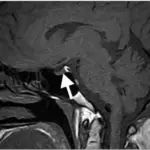Nephrogenic diabetes insipidus is a condition caused by the unresponsiveness of renal tubular to circulating ADH characterized by polyuria owing to the incapability of the kidney to reabsorb water properly from the urine.
What is Nephrogenic Diabetes Insipidus?

Adrenal biopsy findings from a patient with primary aldosteronism. (A) The specimen of an enlarged adrenal gland, measuring 5.7 cm×3.2 cm×1.8 cm, shows its external surface with a focally polypoid appearance. The cut surface shows a relatively well-capsulated diffuse bright yellowish solid mass, measuring 2.0 cm×1.7 cm across. (B) Adrenal biopsy shows cells uniform in size and shape that resemble mature cortical cells. Occasionally, there is some nuclear and cellular pleomorphism but with no evidence of anaplasia. They have uniform nuclei and well-differentiated, abundant cytoplasm (producing cholesterol-rich materials such as hormones). A case of primary aldosteronism combined with acquired nephrogenic diabetes insipidus.
Kim K, Lee JH, Kim SC, Cha DR, Kang YS - Kidney research and clinical practice (2014). Not Altered. CC.


